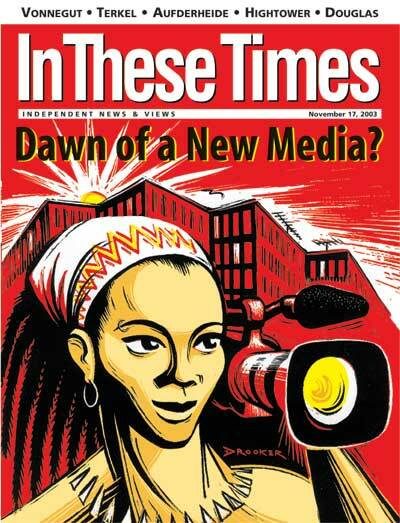
With its talking turd and adolescent T&A it’s easy to dismiss Comedy Central as a joke. But then 11 o’clock ET rolls around, and the upstart basic cable network presents the sharpest 22 minutes of news on TV.
Its own cheeky hype insists, “‘The Daily Show with Jon Stewart’ is the most important television show ever, with the most important guests, hosts and news … of all time,” while its host anchors a self-described fake news program and plays straight man to the day’s events.
The show is embedded in such contradiction. Consider:
In mid-September, U.S. Sen. John Edwards (D-N.C.) formally announced his bid for presidency while talking via satellite with Stewart. That same week Stewart interviewed former Secretary of State Madeleine Albright about her new memoir—the night before she appeared on NPR.
“The Daily Show” won two Emmys for comedy days later and just months after the Television Critics Association nominated it for Outstanding Achievement in News and Information alongside David Bloom, “Frontline,” “Nightline” and “60 Minutes.” (Resist the temptation to disregard TV critics as mere fans; the show also won a prestigious Peabody Award for its election coverage in 2000.)
While interviewing Stewart this summer on “NOW with Bill Moyers,” the veteran newsman confessed, “I do not know whether you are practicing an old form of parody and satire … or a new form of journalism.” Moyers later added: “When I report the news on this broadcast, people say I’m making it up. When you make it up, they say you’re telling the truth.”
But there’s a greater contradiction worth noting: This seemingly agnostic show provides lessons for progressives, in and outside the media, on how to speak with, produce news for and activate the electorate.
As Stewart might say, “Whaaaa?”
The million-plus nightly viewers who tune into “The Daily Show” are college-educated thirtysomethings with salaries that exceed the national norm and skew male, 62 percent to 38 percent. The show continues to build audience within this key demographic, says Steve Albani, a Comedy Central spokesman, because it’s relevant and irreverent.
“It’s one of the few shows out there that can truly speak its mind on current issues,” he says. “We often see a spike in viewers after major events; they want to know Jon’s take on what they just saw. With 24-hour programs there’s an increasing goal of getting news out there fast—oftentimes the news is put out before it’s been confirmed or analyzed. ‘The Daily Show’ peels away layers to see what’s at the core. It doesn’t go for the easy joke. It goes for the joke that makes you laugh and makes you think at the same time.”
Building audience, speaking our minds, lampooning conventions: All are key as progressives seek to recapture the public’s imagination this election cycle.
“People often begin to see their favorite TV personalities as ‘real,’ and develop parasocial relationships with them. The phenomenon of Rush Limbaugh is a great case in point,” says Robbin Crabtree, chair of the Department of Communication at Fairfield University. “A huge number of people see Rush as an opinion leader, as someone ‘in their lives’ whom they trust and on whom they rely, perhaps even as a friend. For liberals, especially but not only, Jon becomes our friend, a sane voice in a cacophony of conservative, uncritical, acquiescent media. We the mass audience don’t know Jon, we don’t know the nuances and complexities of his own political opinions. But his character on TV becomes part of our cadre of real political allies.”
Although he doubts that a “Daily Show” approach could galvanize the left, Mark Andrejevic, with the Department of Communication Studies at the University of Iowa, agrees that the right has been more effective in coalescing and activating its base through media efforts.
“The left has nothing to identify with in that way,” he says. “Creating the possibility of shared identity might be a good starting point for organizing collective political participation.”
As progressives develop a media strategy, Andrejevic suggests we take a lesson from Stewart: “I think it could help to combine values with smartness and humor,” he says. “Maybe there’s something beneficial in changing the left’s image from an ineffectual sincerity to a hipper, smarter but still committed approach to left politics.”
While he certainly seems progressive, Stewart demurred in a New Yorker article last year by Tad Friend: “My comedy is not the comedy of the neurotic. It comes from the center. But it comes from feeling displaced from society because you’re in the center. We’re the group of fairness, common sense and moderation. … The disenfranchised center is upset that the extremes control the agenda.”
Indeed, much of the show gains its humor from the disconnect between common and political speech. Recall Stewart’s riff on presidential hopeful Howard Dean’s first commercial, which closed with the candidate saying, “That’s why I’m running for president. And that’s why I approved this message.” Stewart: “That’s why I approved this message?! All right! A can-do guy who’s in charge of the things that come out of his own mouth!” (To be fair, Dean’s tagline was a way of complying with campaign finance laws.)
Engaging that amorphous middle, to which a majority of Americans say they relate, requires that we speak a common language. In recent years the right has excelled at bumpersticker rhetoric—“family values,” “healthy forests,” “compassionate conservatism”—that lacks nuance and disguises corrupt policies but is memorable and plays into the routines of the mass media, through which a majority of Americans get their political news.
“For the left, coming off as rhetorical is deadly,” says Norman Solomon, executive director of the Institute for Public Accuracy. “Wooden language and buzzwords are apt to seem detached from people’s actual experiences and concerns. We shouldn’t squander a moment with the kind of snoozy, wonky talk that’s so common in what passes for political discourse. Part of the solution is to ‘be here now’—genuinely addressing concerns about the present and the future in down-to-earth ways. Usually, people respond favorably to irreverence that has a point.”
“The Daily Show” is at its best and most biting when it lampoons the media conventions upon which it’s built—objectivity, sourcing and experts all fracture under this scrutiny.
“By mocking and satirizing news, ‘The Daily Show’ draws our attention to media routines,” Crabtree says. “They are interpreting news for comic effect, but there’s a lot to laugh at if we’re critically engaged. It’s the most serious news on television. It’s the only place you’re going to see a critical interrogation of the administration.”
In much the same way, progressives would do well to, if not lampoon, at least reconsider their conventions. Unlike the Christian Right, which routinely updates its narratives and strategies, the left seems trapped in timeworn rhetoric and routines. With activists and a constituency embodying enormous creativity and strength, progressives should be able to retire the hackneyed “Hey, Hey, Ho, Ho …” and other stale mobilization conventions.
But taking too many cues from a comedy show has drawbacks.
“The downside of the program and others like it is the emphasis on humor; the importance of an issue might be obscured,” says Christopher Sharrett, communications professor at Seton Hall University. “Where topics of serious discourse become conflated with entertainment there’s a trivializing of issues. ‘The Daily Show’ is within that realm. There are some interesting issues presented, but we’re in a culture where information is increasingly presented within an entertainment format.”
But that doesn’t mean that as progressives we can’t understand that this “fake” news program has an appeal we’re ill advised to ignore. Last year on Larry King’s CNN show Stewart put it this way: “We often hear that dissenting voices have not been heard since September 11. And that’s been a criticism, that those voices have not been encouraged, but my feeling is that those voices haven’t resonated.”
So how can progressives make their views resonate?
“We need to be pithy, humorous, entertaining, but we ought to draw the line at personal invective,” Solomon says. “We won’t get lost in medialand if we stay true to the values of progressive populism, which include commitment to social equity and zest for pointing out how the corporate emperors have no clothes.”
Its own cheeky hype insists, “‘The Daily Show with Jon Stewart’ is the most important television show ever, with the most important guests, hosts and news … of all time,” while its host anchors a self-described fake news program and plays straight man to the day’s events.
The show is embedded in such contradiction. Consider:
In mid-September, U.S. Sen. John Edwards (D-N.C.) formally announced his bid for presidency while talking via satellite with Stewart. That same week Stewart interviewed former Secretary of State Madeleine Albright about her new memoir—the night before she appeared on NPR.
“The Daily Show” won two Emmys for comedy days later and just months after the Television Critics Association nominated it for Outstanding Achievement in News and Information alongside David Bloom, “Frontline,” “Nightline” and “60 Minutes.” (Resist the temptation to disregard TV critics as mere fans; the show also won a prestigious Peabody Award for its election coverage in 2000.)
While interviewing Stewart this summer on “NOW with Bill Moyers,” the veteran newsman confessed, “I do not know whether you are practicing an old form of parody and satire … or a new form of journalism.” Moyers later added: “When I report the news on this broadcast, people say I’m making it up. When you make it up, they say you’re telling the truth.”
But there’s a greater contradiction worth noting: This seemingly agnostic show provides lessons for progressives, in and outside the media, on how to speak with, produce news for and activate the electorate.
As Stewart might say, “Whaaaa?”
The million-plus nightly viewers who tune into “The Daily Show” are college-educated thirtysomethings with salaries that exceed the national norm and skew male, 62 percent to 38 percent. The show continues to build audience within this key demographic, says Steve Albani, a Comedy Central spokesman, because it’s relevant and irreverent.
“It’s one of the few shows out there that can truly speak its mind on current issues,” he says. “We often see a spike in viewers after major events; they want to know Jon’s take on what they just saw. With 24-hour programs there’s an increasing goal of getting news out there fast—oftentimes the news is put out before it’s been confirmed or analyzed. ‘The Daily Show’ peels away layers to see what’s at the core. It doesn’t go for the easy joke. It goes for the joke that makes you laugh and makes you think at the same time.”
Building audience, speaking our minds, lampooning conventions: All are key as progressives seek to recapture the public’s imagination this election cycle.
Building audience
“People often begin to see their favorite TV personalities as ‘real,’ and develop parasocial relationships with them. The phenomenon of Rush Limbaugh is a great case in point,” says Robbin Crabtree, chair of the Department of Communication at Fairfield University. “A huge number of people see Rush as an opinion leader, as someone ‘in their lives’ whom they trust and on whom they rely, perhaps even as a friend. For liberals, especially but not only, Jon becomes our friend, a sane voice in a cacophony of conservative, uncritical, acquiescent media. We the mass audience don’t know Jon, we don’t know the nuances and complexities of his own political opinions. But his character on TV becomes part of our cadre of real political allies.”
Although he doubts that a “Daily Show” approach could galvanize the left, Mark Andrejevic, with the Department of Communication Studies at the University of Iowa, agrees that the right has been more effective in coalescing and activating its base through media efforts.
“The left has nothing to identify with in that way,” he says. “Creating the possibility of shared identity might be a good starting point for organizing collective political participation.”
As progressives develop a media strategy, Andrejevic suggests we take a lesson from Stewart: “I think it could help to combine values with smartness and humor,” he says. “Maybe there’s something beneficial in changing the left’s image from an ineffectual sincerity to a hipper, smarter but still committed approach to left politics.”
Speaking our minds
While he certainly seems progressive, Stewart demurred in a New Yorker article last year by Tad Friend: “My comedy is not the comedy of the neurotic. It comes from the center. But it comes from feeling displaced from society because you’re in the center. We’re the group of fairness, common sense and moderation. … The disenfranchised center is upset that the extremes control the agenda.”
Indeed, much of the show gains its humor from the disconnect between common and political speech. Recall Stewart’s riff on presidential hopeful Howard Dean’s first commercial, which closed with the candidate saying, “That’s why I’m running for president. And that’s why I approved this message.” Stewart: “That’s why I approved this message?! All right! A can-do guy who’s in charge of the things that come out of his own mouth!” (To be fair, Dean’s tagline was a way of complying with campaign finance laws.)
Engaging that amorphous middle, to which a majority of Americans say they relate, requires that we speak a common language. In recent years the right has excelled at bumpersticker rhetoric—“family values,” “healthy forests,” “compassionate conservatism”—that lacks nuance and disguises corrupt policies but is memorable and plays into the routines of the mass media, through which a majority of Americans get their political news.
“For the left, coming off as rhetorical is deadly,” says Norman Solomon, executive director of the Institute for Public Accuracy. “Wooden language and buzzwords are apt to seem detached from people’s actual experiences and concerns. We shouldn’t squander a moment with the kind of snoozy, wonky talk that’s so common in what passes for political discourse. Part of the solution is to ‘be here now’—genuinely addressing concerns about the present and the future in down-to-earth ways. Usually, people respond favorably to irreverence that has a point.”
Lampooning conventions
“The Daily Show” is at its best and most biting when it lampoons the media conventions upon which it’s built—objectivity, sourcing and experts all fracture under this scrutiny.
“By mocking and satirizing news, ‘The Daily Show’ draws our attention to media routines,” Crabtree says. “They are interpreting news for comic effect, but there’s a lot to laugh at if we’re critically engaged. It’s the most serious news on television. It’s the only place you’re going to see a critical interrogation of the administration.”
In much the same way, progressives would do well to, if not lampoon, at least reconsider their conventions. Unlike the Christian Right, which routinely updates its narratives and strategies, the left seems trapped in timeworn rhetoric and routines. With activists and a constituency embodying enormous creativity and strength, progressives should be able to retire the hackneyed “Hey, Hey, Ho, Ho …” and other stale mobilization conventions.
But taking too many cues from a comedy show has drawbacks.
“The downside of the program and others like it is the emphasis on humor; the importance of an issue might be obscured,” says Christopher Sharrett, communications professor at Seton Hall University. “Where topics of serious discourse become conflated with entertainment there’s a trivializing of issues. ‘The Daily Show’ is within that realm. There are some interesting issues presented, but we’re in a culture where information is increasingly presented within an entertainment format.”
But that doesn’t mean that as progressives we can’t understand that this “fake” news program has an appeal we’re ill advised to ignore. Last year on Larry King’s CNN show Stewart put it this way: “We often hear that dissenting voices have not been heard since September 11. And that’s been a criticism, that those voices have not been encouraged, but my feeling is that those voices haven’t resonated.”
So how can progressives make their views resonate?
“We need to be pithy, humorous, entertaining, but we ought to draw the line at personal invective,” Solomon says. “We won’t get lost in medialand if we stay true to the values of progressive populism, which include commitment to social equity and zest for pointing out how the corporate emperors have no clothes.”
Cynthia Moothart is managing editor for content at In These Times.






